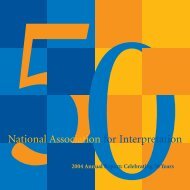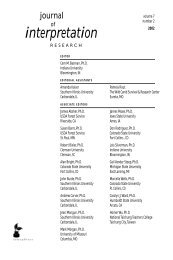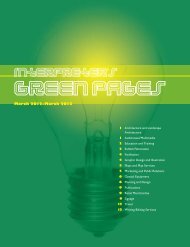interpretation
Volume 15, Number 1 - National Association for Interpretation
Volume 15, Number 1 - National Association for Interpretation
You also want an ePaper? Increase the reach of your titles
YUMPU automatically turns print PDFs into web optimized ePapers that Google loves.
o l i v i a b u c k<br />
Testing Length and Tone<br />
We have researched visitor responses to different styles and lengths of text. Visitors tend<br />
to prefer text that includes dates and facts, but that is presented in an easily readable<br />
style. We want interpretive texts to have a distinctive voice, often the curator’s voice,<br />
so that each gallery or exhibition has a different feel. This variety in style of the text,<br />
combined with the use of contemporary quotes and other media gives visitors variety<br />
and can enable them to engage more with objects.<br />
We may, for instance, include language that helps visitors gain an emotional<br />
response to the objects. We have found that when visitors have had an emotional<br />
response to a display it often makes it more memorable. This example of a label from<br />
the Japan gallery shows the use of emotive language to create a connection between the<br />
visitor and the object:<br />
Portrait of a retired townsman<br />
The figure gazes out at us with an air of calm. His crystal eyes give him<br />
a gently human expression. Many successful townsmen, as they grew<br />
older, took Buddhist vows. Like monks they often had their heads shaved,<br />
abandoning vanity. Some continued to live busy secular lives, others went<br />
into semi-retirement to prepare spiritually for death.<br />
Townspeople believed that by making portraits such as this one, often as<br />
a memorial after death, they would preserve the success of their family. In<br />
effect the head of the household was still watching over them.<br />
Interpretive media<br />
Diversity of information and media can help visitors to engage with objects. In any<br />
project there are a range of interpretive devices offering different modes of engagement<br />
and catering for varied learning styles. For the Japan gallery high-level texts, panels,<br />
labels, images, a gallery guide, the museum multimedia guide, the museum map, gallery<br />
talks, and other events provide visitors with variety of entry points. There must be a<br />
clear hierarchy between these distinct media. Furthermore, various writing styles and<br />
voices will be appropriate for each of the different media. This article focuses on the<br />
more traditional forms of interpretive writing such as panels and labels, but these should<br />
be considered alongside other interpretive devices and not in isolation.<br />
Interpretive writing process<br />
Our evaluation research has enabled us to develop some guidelines for writing interpretive<br />
text at the British Museum. We have a constantly evolving house style, as well as guidance<br />
on word lengths for panels and labels. We always consider our audience, visitors to the<br />
museum itself, but also specific target audiences identified for different exhibitions. All<br />
our object-specific texts start with what the visitor can see to help them look at the objects<br />
more closely. This enables visitors to engage more deeply with our collections.<br />
We have developed a text sign-off process: once the <strong>interpretation</strong> officer and the<br />
curator have agreed the text, it is circulated to all other stakeholders for their comments.<br />
We also ensure that for major projects at proof stage a second <strong>interpretation</strong> officer,<br />
who has not been involved in the project, reads all the texts as a final check for proofing,<br />
consistency and sense.<br />
48 j o u r n a l o f i n t e r p r e t a t i o n r e s e a r c h












